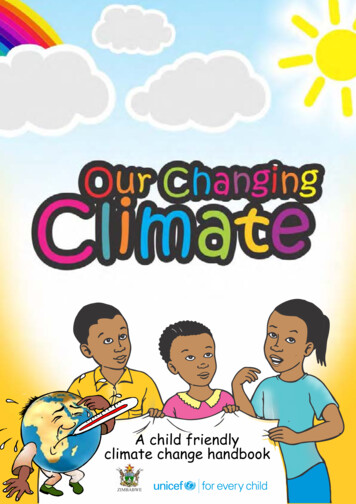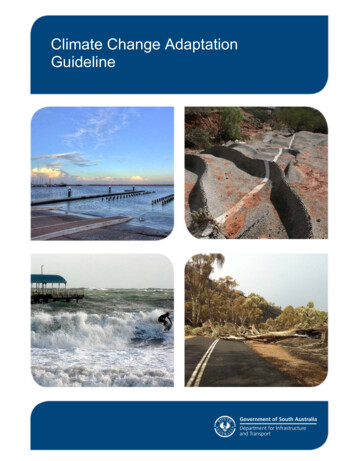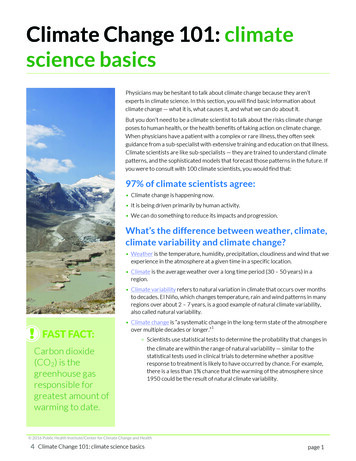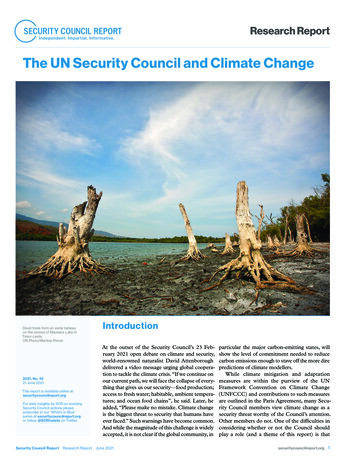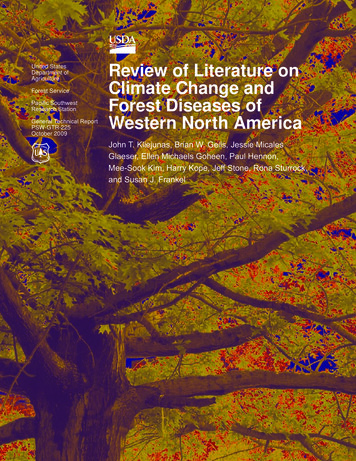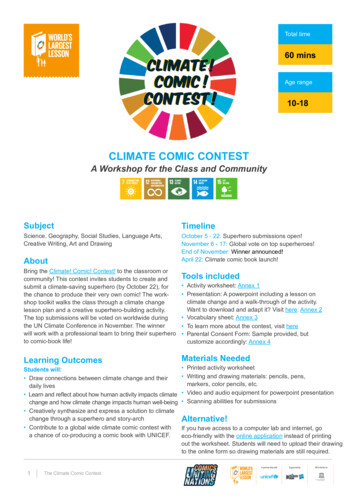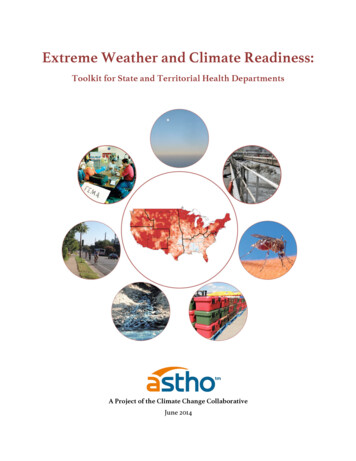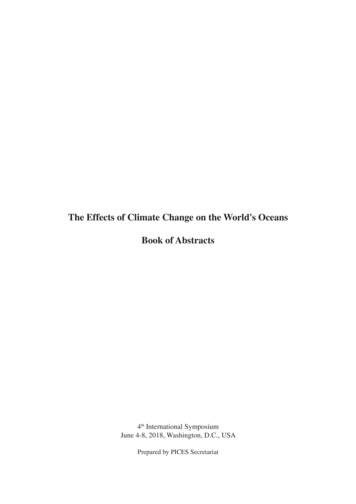
Transcription
The Effects of Climate Change on the World's OceansBook of Abstracts4th International SymposiumJune 4-8, 2018, Washington, D.C., USAPrepared by PICES Secretariat
Table of ContentsSession and Workshop Descriptions 3AbstractsPlenary Sessions (ordered by day) 34Sessions, Oral Presentations (June une 5, June 8) 41(June 7) 54(June 5) 62(June 6) 71(June 4) 79(June 4) 87(June 7) 92(June 4, June 8) 100(June 4) 106(June 6) 114(June 7, June 8) 122(June 4, June 5) 135(June 5) 146(June 6, June 8) 155(June 6) 167(June 4) 174(June 7) 178Workshops, Oral Presentations (June 91011(June 2) 186(June 2) 190(June 3) 193(June 3) 196(June 3) 198(June 2) 202(June 3) 207(June 3) 209(June 2) 212(June 3) 214(June 3) 219Sessions, Poster Presentations (June nSessionSessionSessionSession1 2212 2263 2334 2445 2466 2507 2518 2559 25710 26111 2701
SessionSessionSessionSessionSessionSession12 27813 28514 29316 30017 30218 303Workshops, Poster hopWorkshop3 3066 3077 3088 3099 31110 312List of Registrants 313Author Index 3612
Sessions and Workshops Descriptions3
2018-Effects of Climate Change on World's OceansSession 1: Ocean extremes and their impact on marine ecosystemsConvenors:Thomas L. Frölicher (University of Bern, Switzerland)Gabriel Reygondeau (Institute for the Oceans and Fisheries, The University of British Columbia,Canada)Emanuele Di Lorenzo (Georgia Institute of Technology, GA, USA)Plenary Speaker:Alistair Hobday (CSIRO Oceans and Atmosphere, Hobart, Australia)Invited Speaker:Rebecca G. Asch (East Carolina University (ECU), USA)Description:Extreme climate and weather events shape the structure of biological systems and affect the biogeochemicalfunctions and services they provide for society in a fundamental manner. There is overwhelming evidence thatthe frequency, duration, intensity and timing of extreme events on land are changing under global warming,increasing the risk of severe, pervasive and in some cases irreversible impacts on natural and socio-economicsystems. In contrast we know very little about how extreme events in the ocean, especially those associatedwith warming, acidification, deoxygenation and nutrient stress, will unfold in time and space. In addition, ourunderstating of the impact of ocean extreme events on marine organisms and ecosystem services is very poor. Thissession seeks current knowledge as well as new and evolving insights into modeling and observational efforts thatadvance our understanding of the regional and global short-term and long-term changes in marine extreme events(heat waves, hypoxia, acidification, nutrient stress) and how these events impact marine organisms, biodiversityand ecosystem services4
2018-Effects of Climate Change on World's OceansSession 2: From prediction to projection: The role of seasonal to decadal forecasts in achanging climateConvenors:Mark R. Payne (DTU-Aqua, Technical University of Denmark Copenhagen, Denmark)Erica Ombres (NOAA OAR Ocean Acidification Program, USA)Michael Jacox (University of California Santa Cruz, Institute of Marine Sciences, NOAA SouthwestFisheries Science Center, USA)Masami Nonaka (Japan Agency for Marine-Earth Science and Technology (JAMSTEC), Yokohama,Japan)Plenary Speaker:Lisa Goddard (International Research Institute for Climate and Society, Columbia University, USA)Invited Speaker:Katherine E. Mills (Gulf of Maine Research Institute, Portland, ME, USA)Description:Research examining the future impacts of environmental change and variability on ocean ecosystems hashistorically been focused on making projections on multi-decadal to centennial time scales. Nevertheless, recentyears have seen the emergence of the first generation of marine ecosystem predictions working on shortertimescales (i.e. seasonal, annual and decadal scales). These forecasts are tailored to the tactical decision-makingtimescales of individuals, businesses, sectors or governments and inform strategies for coping with and adaptingto climate change and variability. They also form a natural continuum with projections on the climatic timescale:many of the techniques used are similar, and testing predictability in the short-term builds confidence in ourability to project in the long-term. In this session, we welcome contributions on a broad range of potential futureimpacts on ocean ecosystems, including (but not limited to) ocean warming, circulation changes, acidification,eutrophication, hypoxia, and ecosystem structure or function. We seek research that addresses prediction of theseecosystem impacts as well as its relationship to long-term projections; relevant topics include 1) mechanismsthat generate predictability in ocean ecosystems, 2) methods for statistically and/or mechanistically forecastingphysical and/or biological variables, 3) case studies of existing biological forecast systems, 4) requirements forforecasts - including end-user needs - and assessment of forecast value, and 5) uses of forecasts within a climatechange adaptation context. Contributions that link the time-scales of prediction and projection and highlightexamples of what one field can learn from the other are particularly encouraged.5
2018-Effects of Climate Change on World's OceansSession 3: Carbon uptake, ocean acidification, and ecosystems and human impactsConvenors:Masahiko Fujii (Hokkaido University, Japan)Tsuneo Ono (Japan Fisheries Research and Education Agency)Libby Jewett (NOAA)Galen A. McKinley (Columbia University/Lamont Doherty Earth Observatory)Nianzhi Jiao (Xiamen University)Plenary Speaker:Naomi Harada (RCGC, JAMSTEC, Japan)Invited Speaker:Nicole Lovenduski (University of Colorado Boulder, USA)Description:By absorbing significant quantities of CO2, the ocean provides a critical climate regulation service. At the sametime, carbon uptake is altering marine biogeochemistry, food web and ecosystem properties. Other drivers oflarge-scale degradation of the marine environment have been widely reported, specifically temperature-drivencoral bleaching and hypoxia. Yet, there exist significant uncertainties. The long-term ability of the ocean to absorbcarbon and thus to modulate climate is a critical question of utmost relevance to international climate negotiations.Uncertainties with respect to impacts on marine ecosystems and human society hinders the effective managementof ocean resources.In this session, we will explore a range of physical, biogeochemical, and sociological interactions that impact theocean CO2 sink, rates of acidification, and ecosystem impacts. Presentations will characterize the physical andbiogeochemical processes driving current and projected future CO2 uptake, variability, and long-term trends.Advanced methods both for observing CO2 uptake, and for modeling its variability and change will be discussed.Contributions are also welcome from observational, experimental, modeling and socio-economic studies onocean acidification, hypoxia, biological carbon sequestration and related ecosystem dynamics with variousspatio-temporal scales, from local to global and from short to long-term. Linkages between these processes withpotential development of international observing and modeling networks, vulnerability assessments, managementstrategies and integrative studies are particularly welcome.6
2018-Effects of Climate Change on World's OceansSession 4: Deoxygenation in Global Ocean and Coastal Waters in Relation toClimate ChangeConvenors:Denis Gilbert (Pelagic and Ecosystem Science Branch, Maurice-Lamontagne Institute, Fisheries andOceans Canada, Québec, Canada)Nancy N. Rabalais (Department of Oceanography and Coastal Sciences, Louisiana State University,USA)Plenary Speaker:Dimitri Gutierrez (IMARPE, Perú)Invited Speakers:Francisco Chavez (Monterey Bay Aquarium Research Institute (MBARI), CA, USA)Lothar Stramma (GEOMAR Helmholtz Center for Ocean Research Kiel, Germany)Description:Deoxygenation in the open ocean, upwelling systems, oxygen minimum zones, and coastal waters is expected toaccelerate over the next decades in response to warming-induced reduction in O2 solubility and increased oceanstratification that would diminish ventilation of marine waters. In addition, multiple stressors from eutrophicationworsen oxygen depletion in coastal waters where hypoxia and harmful algal blooms (including those that aretoxin producers) is now a prevalent and worsening situation. Observations indicate that the global ocean oxygeninventory has already decreased by 2% over the past five decades, and the volume occupied by oxygen minimumzones (OMZ) quadrupled over the same time period. Many questions are raised for open ocean and coastal waters.Do the spatial and temporal patterns of observed oxygen changes match projections from climate change models?Do large-scale patterns of atmospheric and oceanic variability such as ENSO (El-Niño Southern Oscillation),the Pacific Decadal Oscillation, the North Atlantic Oscillation or the Southern Annular Mode prevent us fromdetecting multi-decadal oxygen trends with confidence because of a signal to noise ratio that still remains too low?Should we expect that coastal waters, because of their adjoining landscapes and oceanscapes, will be variablyaffected by warming? Changes in temperature, winds and currents will alter physical processes. Biological processrates should increase up to some point where other limiting factors may intervene. Climate-driven changes inlandscape use, particularly agriculture, will occur along with changes in precipitation, weather patterns, freshwaterdischarge and nutrient loads, all drivers of physical structure and biological production that can cause changes indissolved oxygen concentrations in the lower water column. How does global warming affect the ocean’s densitystratification, vertical mixing rates, deep convection, and ventilation processes in the main thermocline? What arethe expected impacts of deoxygenation on various trophic levels, on biogeochemical cycles, on fisheries and onecosystem functions and services? How can studies of paleo-indicators shed light on what we may expect in thefuture?In this session we are seeking contributions that will help address the physics and biogeochemistry of deoxygenation– from continental shelves to the deep ocean – from various angles: causes, impacts, monitoring and modeling. Wewelcome presentations that include long-term observations that help conceptualize the intricacies of how interrelated biological and physical processes drive oxygen changes.7
2018-Effects of Climate Change on World's OceansSession 5: Climate change impacts on high latitude systems on multiple scales in spaceand timeConvenors:William Perrie (Bedford Institute of Oceanography, DFO, Canada)Vincent Saba (NOAA National Marine Fisheries Service, Princeton NJ, USA)Invited Speaker:Grace Saba (Rutgers University, NJ, USA)Description:This session focuses on climate impacts on high latitude systems and northern and southern polar regions at bothregional (e.g., Bering Sea, Beaufort Sea, Barents Sea, Labrador Sea) and broader spatial scales (e.g., Arctic Oceanand the Southern Ocean). We seek papers that evaluate climate impacts at time scales ranging from seasonal,decadal, to multi-decadal. Included topics might be: (a) Seasonal time scales, for example, estimates of Septemberice conditions and links to preceding winter and early spring atmosphere or ocean conditions; (b) The impacts ofclimate change on high latitude and Arctic or Southern Ocean storms and their impacts and feedbacks on the upperocean; (c) The role of inertial gravity waves, mesoscale and sub-mesoscale eddies and related processes on mixedlayer depths, vertical mixing, and on the ice edge etc; (d) Estimates of climate and climate change on longer timescales, up to the next several decades, e.g. following IPCC scenarios; and (e) Climate impacts on high latitudeecosystems and ecosystem services (i.e. fisheries)8
2018-Effects of Climate Change on World's OceansSession 6: The deep ocean under climate changeConvenors:Nadine Le Bris (University Pierre and Marie Curie, France)Andrew Sweetman (The Lyell Centre, Heriot-Watt University, UK)Invited Speakers:Lisa Levin (Center for Marine Biodiversity and Conservation, Scripps Institution of Oceanography,UC San Diego, USA)Murray Roberts (School of GeoSciences, University of Edinburgh, UK)Description:Covering over half of the planet, and comprising 95% its habitable volume, the deep ocean ( 200 m) is criticalto any analysis of the role of the ocean in climate mitigation and adaptation. Beyond its capacity to absorb excessheat, the deep ocean has a predominant role in sequestering carbon and removing it from the atmosphere. Thedeep sea hosts a broad range of pelagic and benthic ecosystems, which provide services that are vitally importantto the entire ocean and biosphere, ranging from nutrient cycling to habitat provision, including greenhouse-gasregulation, support to biodiversity (including genetic diversity), food supply and energy production.Today, significant changes in the environmental properties of the ocean realm in terms of water column oxygenation,temperature, pH and food supply, with concomitant impacts on deep-sea ecosystems are being recorded at greatdepth. Recent projections suggest that abyssal (3000–6000 m) ocean temperatures could increase by 1 C over thenext 84 years, while abyssal seafloor habitats under areas of deep- water formation may experience reductionsin water column oxygen concentrations by as much as 0.03 mL L-1 by 2100. Bathyal depths (200–3000 m)worldwide are predicted to undergo the most significant reductions in pH in all oceans by the year 2100 (0.3 to0.4 pH units). O2 concentrations may also decline in the bathyal NE Pacific and Southern Oceans, with lossesup to 3.7% or more, especially at intermediate depths. Another important environmental parameter, the flux ofparticulate organic matter to the seafloor, is likely to decline significantly in most oceans, most notably in theabyssal and bathyal Indian Ocean where it is predicted to decrease by 40–55% by the end of the century.However, how these changes will affect deep-sea ecosystem (both benthic and pelagic) functions and the ecosystemservices the deep sea provided are just starting to be inventoried. There are, in particular, still large gaps in ourknowledge of deep hydrology, hydrography, pelagic and seafloor ecology that must be filled to anticipate howthese changes may impair ecosystems at depth and potential feedbacks to surface waters. The growing imprint ofhuman activities at great depths, including contaminant accumulation, overfishing, and disturbances from seafloorextractive activities, further justifies the need for a better understanding of how direct impacts will interact withclimate stressors.New knowledge is critical to improve predictions and assess societal impacts, and requires the expansion ofdeep-water observing programs with experimental capacities, to support the design of marine protected areasencompassing vulnerable regions in deep waters, and to inform environmental management of industrial activitiesand development of new policies addressing deep national and international waters. There is also an unprecedentedneed to integrate the deep ocean into ocean science and policy. New international regulations (e.g, for mining)and treaties (e.g. for biodiversity), environmental management, and spatial planning also must incorporate climatechange impacts on deep ocean-processes.In this session, we invite presentations that describe how climate stessors may alter deep-ocean ecosystems,as well as their combination with other occurring anthropogenic stressors (e.g., fishing, mineral mining), andwhat the possible societal implications may be. Current initiatives and observing programs, scientific and policyadvances and technological developments that will contribute to this effort are also welcome.9
2018-Effects of Climate Change on World's OceansSession 7: Eastern Boundary upwelling systems: diversity, coupled dynamics andsensitivity to climate changeConvenors:Ivonne Montes (Instituto Geofísico del Perú)Ryan Rykaczewski (Department of Biological Sciences and Marine Science Program, University ofSouth Carolina, USA)Plenary Speaker:Andreas Oschlies (Marine Biogeochemical Modelling at GEOMAR and the University of Kiel,Germany)Invited Speaker:Véronique Garçon (LEGOS Laboratoire d'Etudes en Géophysique et Océanographie Spatiales, CNRS,Toulouse, France)Description:The Eastern Boundary Upwelling Systems (EBUS) are the most productive areas of the world’s oceans,supporting large populations of commercially important fish species. The basic forcing mechanism are similaracross the different EBUS. However, owing to differences in the relative strengths of potential stressors, a unifiedunderstanding regarding the sensitivity of individual EBUS to climate change remains evasive. In this session,we focus on the different physical mechanisms occurring over different time scales (i.e., intradaily, intraseasonal,interannual, decadal, multidecadal) and their implications for water-column properties, biogeochemical cycles,biodiversity/ecosystem structure and functioning, and the regional climate. We seek to identify the key feedbackprocesses in EBUS, appreciate the similarities across systems, and understand the differences. We also intendto identify critical knowledge gaps that limit our current understanding of physical and ecological responses tonatural and anthropogenic climate forcing in EBUS.10
2018-Effects of Climate Change on World's OceansSession 8: Understanding the impact of Abrupt Ocean Warming and Continental ScaleConnections on marine productivity and food security via Western Boundary CurrentsConvenors:Ellen Mecray (NOAA / NESDIS / NCEI)Avijit Gangopadhyay (UMassD / SMAST)Hassan Moustahfid (FAO, UN)John Quinlan (NOAA / NMFS / SEFSC)Plenary Speaker:Fan Wang (Institute of Oceanology, CAS, Qingdao, China)Invited Speaker:Hassan Moustahfid (Food and Agriculture Organization of the United Nations (FAO))Description:Living marine resources and the coastal communities that depend on them are shifting in response to rapidphysical and environmental changes. How are these changes being monitored and measured when connectedon large scales by boundary currents and differing management regimes? Recent physical oceanographic studieshave shown that changes in the intensity and position of several western boundary currents have already beenobserved. Specifically, the Kuroshio and Agulhas Currents have shifted their paths poleward. The consequences ofsuch changes for ecosystems, and especially for marine productivity and fisheries, are beginning to emerge. Theimpact of Arctic meltwater and the North Atlantic Oscillation on the Atlantic Meridional Overturning Circulationand the Gulf Stream have been observed over a few decades now. These changes may be related to disappearingcod and other species from the western north Atlantic and introduction of some new species in the North Atlantic.Similar regime shifts in the productivity of several small pelagic fish species also have severe implications onfood security and malnutrition of coastal communities, particularly in West Africa. This session will examinethe physical and biological changes measured and documented in western boundary current regimes (e.g., LoopCurrent / Gulf Stream, Kuroshio, Brazil, East Australian, and Agulhas Currents), with special emphasis on howthese changes impact species range shifts, phenology, species interactions, resource management planning andadaptation, as well as the food security and social fabric of coastal communities.We welcome larger community participation from ocean, climate and fisheries scientists to present advances in (i)understanding physical and biological linkages (ii) boundary current variabilities and trends under climate changeand/or (iii) the impact of recent changes in western boundary currents on marine life, productivity, fisheries andfood security.Additional emphasis will be placed on the examination of oceanic and estuarine ‘hotspots’ in these systems, andany evidence for specific areas that can provide environmental refugia for living marine resources.11
2018-Effects of Climate Change on World's OceansSession 9: Drifting into the Anthropocene: How will pelagic marine ecosystems be affectedand what are the biogeochemical and lower trophic consequencesConvenors:Todd O’Brien (NOAA Fisheries, USA)Angelica Peña (Institute of Ocean Sciences, Canada)Invited Speaker:Laura Lorenzoni (Ocean Biology and Biogeochemistry Program (OBB), NASA Headquarters ScienceMission Directorate)Description:Climate-related changes in the physical and chemical oceanic environment impact the biological andbiogeochemical components of marine ecosystems. These impacts take effect at a variety of spatial and temporalscales, and at varying magnitudes, and often differ greatly between geographic regions and realms (e.g., polar vs.equatorial, shelf vs. open ocean). Ultimately, these changes can greatly alter the productivity, biodiversity, andresilience of the marine ecosystems that depend on them.Since the first ECCWO in 2008, numerous studies have documented changes in ocean acidification, deoxygenationand carbon cycling, planktonic biodiversity and biogeographic range, and the phenology and strength of seasonalevents (e.g., spring blooms, onset and strength of stratification, extent and presence of sea ice). Have theseinstances and impacts changed in magnitude, severity, or geographic extent since 2008, and are new impacts andside-effects now being uncovered?This session will look at observed and predicted causes and impacts of climate-related changes within pelagicmarine lower trophic levels (e.g., microbes, plankton, larval fish) and biogeochemical components (e.g., carbon,oxygen and nutrient cycling), including studies using systematic and sustained ocean observations and modeling.12
2018-Effects of Climate Change on World's OceansSession 10: Management and Conservation of Species on the MoveConvenors:Charles Stock (USA)Shin-ichi Ito (Japan)Thomas Therriault (Canada)Wendy Morrison (USA)Samantha Twiname (Australia)Plenary Speaker:Gretta Pecl (IMAS, CMS, Tasmania, Australia)Invited Speakers:Jorge García Molinos (Arctic Research Center, University of Hokkaido, Sapporo, Japan)Malin Pinsky (Rutgers University, NJ, USA)Description:Most fisheries and marine conservation efforts have been managed under the assumption that species distributionsare static or fluctuate around historical averages. Sustained scientific surveys and new technologies, however, haverevealed persistent climate-driven movements. In some areas, this has resulted in movements across managementjurisdictions. Such movements are projected to continue under global warming, creating difficult questions formanagers trying to balance coastal economic interests and conservation goals. For example, do past observedshifts reflect future responses? How will the invasion of new species impact resident populations? How willshifted species adapt to new environments? When should new fisheries be established? When is a historicallyproductive fishery extirpated? Should protected areas be relocated? How should historical quotas be adjusted forrange shifts? This session welcomes ecosystem, policy and economic research aimed at answering such qu
The Effects of Climate Change on the World's Oceans. Book of Abstracts. 4. th. International Symposium June 4-8, 2018, Washington, D.C., USA. . from local to global and from short to long-term Linkages between these processes with . How can studies of paleo-indicators



